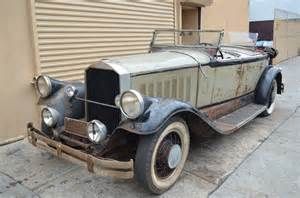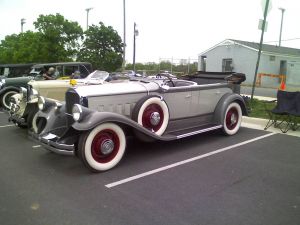- Home
- About Us
- Join/Renew
- Member Benefits
- Member Pages
- Log In
- Help
- Museum Store
Yes, thanks for getting that page on Facebook….I don’t see it, is there a way to have a PAS membership form on the site, or a prominent link to same?
By the way, Richard said the cost to rework the wire wheels was a stunner…think he went all chrome….can’t wait to see the car finished, and see his color and other choices, will be glad to see another car back on the road..
Ed makes an excellent point about the true cost of inexperienced people working on a specialized car.
Robert, unfortunately the ad would have to read it’s just a sew-sew time….
I’ve been in contact with Richard, car is progressing, he’s waiting for some chrome to get finished, then the car will be assembled and sent to the trimmer for upholstery.
He stated the trimmer has never done a 20’s Pierce, and I offered any assistance I can give him on the top and interior, so the trimmer is getting my phone number.
Giving free advice, hmmmm….now if I just had one of those “pay by the minute”” phone numbers to give out…”
Reminds me of the ’34 Pierce basket case I pulled out of a field here in Virginia.
Two friends, a father and son, good ole country boys, went with me to pick it up.
As we approached the car, the son looked at the father and asked, hear that? I was clueless. He had heard a low hum, which turned out to be a large wasp nest running down the frame.
Had he not heard it, there could have been some serious damage to yours truly.
I hope Richard does reply. and has some more progress and images to share..
Yes, I just picked a post and replied to it. I don’t think Richard can see nor reply, since he’s not a member of the PAS any more, correct?
From what I saw of the ongoing restoration, and knowing what he paid for car, I doubt financial recovery is possible, but I’ve been wrong before. The initial cost of the car and just the chrome plating cost would probably have had him into six figures.
I went back and looked, and the car was in better cosmetic shape than I remembered when unrestored. Just a mechanical rebuild to start would have been an interesting choice….it’s still a little rough, but it would have drawn a lot of attention….
Chrome costs today are crazy. The chrome bill on this car would actually buy some older restoration Classic sedans….

That’s a shame, wonder if he just lost interest or the costs got too high…..good project but a little rough to start with…
How’s this car coming along? Haven’t heard anything for a while……
Each ounce adds 1/64 inch to the thickness, thus, 2 ounce leather (the weight of a square foot of the hide) is 1/32 inch thick.
Is that woven material asbestos?
Peter, I can appreciate the warning. However, woven, or bonded, asbestos poses no threat whatsoever to anyone’s health. It’s only when it’s made into dust, or in the OSHA terminology “becomes friable”, does it pose an inhalation danger.
There may be some slight loose material from wear, but as long as it doesn’t become airborne it’s not a danger. Wipe it down, don’t use an air stream.
Thus, handling asbestos pads or brake shoes is no problem, while sanding or grinding on them to make them fit does pose an issue.
Indeed, a reference that involves Earl “keep your boots on for traction” Long.
I have a picture of what I believe is that ’34 in my files, when it was for sale in the 1980’s, and back when you had to ask for pictures in the mail. I almost bought it, but we all know what almost means…
Very nice solution to the problem and great write up, thanks for sharing. I tried to make some corners using just leather, was not overly pleased with result.
I have a hide of nice black 2 ounce leather in my stockpile, if anyone needs some let me know.
The good thing about your car (from a trimmer’s perspective, that is, there are a LOT of other good things about it!) is that, with the lower top, it will fit into a regular height garage. That’s the problem right now with the 1919 top I’m doing, I can’t finish it in my workspace, not enough ceiling height. So, basically, we’ll have the top framework on a jig that replicates the body mounting, I’ll rough out the top pieces, then final fitting will be on the car at another location.
One fun thing about the 1919, the wood bows are covered with leather where they show on the sides of the car. This is wrapped around, with the seam hidden under the screwed-on irons. Earlier cars had leather wrapped sockets, with the seam visible.
You’ll find that the side curtains are just about as expensive as the top. To do them correctly takes a lot of time and detail work, plus the fitting to the car. If you have a set of old side curtains, make sure your trimmer uses them for reference, not pattern, as they can shrink and stretch in funny ways. The side curtains must be fit to the car as they are made…..
Great car, sounds like you’re having a blast with it! And yes, the Pierce Arrow gang is a great group, remember, we’re not just a club, we’re a Society!
Great story of the drive!
Wish we were closer, that would be a fun car to put a top on. I have a 1919 top that I’m working on now, in between other jobs.
That said, I’m trying to get out of the trimmer work, I do it as a hobby now that I’m retired, but I’m not getting any of my own work done!
Bill, that’s a very handsome Pierce, congratulations!
The top profile is more 1930 than 1916! I’d be interested to see the mechanism (steel framework). The low top does make a nice appearance.
I would suggest you put the tie downs to the axle, not the wheels as shown, as that point load would put undue stress on the spokes. I think I can see a winch cable attached to the axle, which is good.
Welcome to the Wonderful World of Pierce Arrows!
Mike, nice car! Could you send me, or post here, a picture of the clamps that are on the crossbar? I’m assuming they hold the stone guard in place. Thanks [email protected]
Merry Christmas and Happy New Year!
We’ve been getting very little snow in Virginia, so a picture without it will have to do….but my little man does have his raincoat on, just in case of rain!

Industrial chrome plating was “invented” early in the 20th century, but not perfected until 1924. In 1927, chrome started showing up on some automobile parts, particularly bumpers.
My personal experience has been that chrome seemed to start really showing up on and in automobiles around 1929. Prior to that, most brightwork was nickel plated.
Chrome (for automobile decorative use, excluding hard chrome which is a totally different subject) is actually a very thinly deposited layer over brightly polished nickel. While nickel will tarnish easily, the chrome won’t, thus it became very popular for bright work…
You can read more on attached link is so inclined….
Funny how, with such a limited number of Pierce automobiles extant, they’re known by previous owners.
It won’t mean much to a lot of you, but there are a LOT of Louisiana old car guys that know my ’31 phaeton as “Drew’s Pierce”, a tribute to a gentleman named Drew Navarre from New Orleans who bought the car in 1959,restored it 1959/1960, and toured it extensively through the 60’s and 70’s, and literally wanted to sell it to me in the 1980’s.
I’m forever thankful to him for letting me be the next caretaker….
